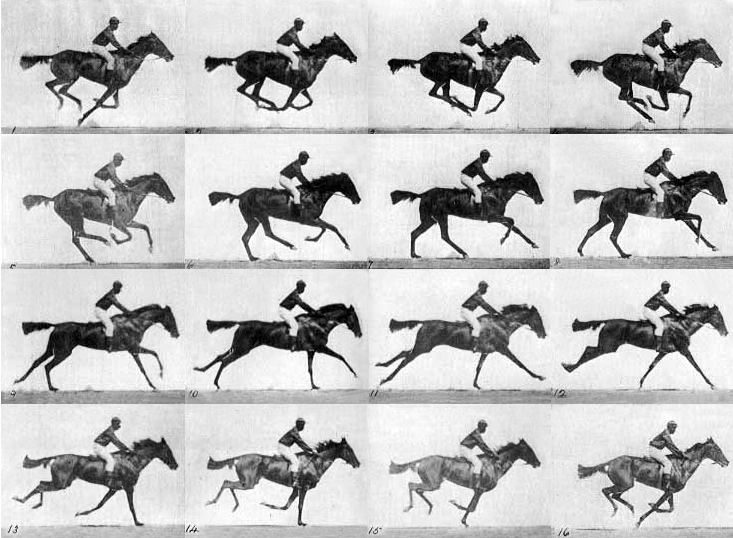Film History
It is important to understand the basics before diving into any subject or activity. Welcome to a brief overview of the history of the film industry.
24 Frames
It all began in 1877 when Leland Stanford, the California governor, hired Eadweard Muybridge, who was experimenting with continuous motion photography, to prove that when a horse gallops, all four of its feet are off the ground at the same time. Muybridge rigged 24 cameras that were triggered in synchronized fashion by string stretched across a racetrack. The photos showed Stanford was right.¹

Kinetoscope and the First Studio
In the 1880’s, Thomas Edison tried to find a way to have pictures accompany his phonograph. At the time George Eastman was experimenting with celluloid film. Edison with his assistant, W.K.L. Dickson, bought this film from Eastman and began making short films with Dickson’s electrically powered camera and Kinetoscope. By the 1890’s Kinetoscope parlors opened up all over the US and for a few pennies people could view a 20 second movie through a peephole at the top of the box. On a side note, celluloid film was highly flammable. When caught on fire celluloid creates its own oxygen so the fire burns bigger and brighter than you can imagine. This was a major problem back then, one wrong move and you could see your film and set go up in flames right before your eyes. This is where the fear of fire in a movie theater originates.

The 1888 Kinetoscope
In 1893, the world’s first film production studio, the Black Maria, or the Kinetographic Theater, was completed on the grounds of Edison’s laboratories at West Orange, New Jersey, for the purpose of making film strips for the Kinetoscope.² The studio’s roof opened up to let in sunlight and the entire studio rotated to follow the sun. The outside was covered in tar paper and the temperature inside rose significantly. The camera was positioned in a stationary position inside and would never be moved during filming. Edison and Dickson dealt mainly in shorts involving a guy sneezing, a couple kissing, various animal acts, or a girl dancing. Their first movie, Fred Ott’s Sneeze released in 1894.

The Black Maria, world's first film production studio
The Lumière Bros. and the Portable Camera
1895 France saw the first functional film projector, invented by Auguste and Louis Lumière, in the basement of a café. The Lumière Brothers also used a smaller hand-cranked camera, the cinematograph, to document everyday events outside. Due to its portability and basic design, the cinematograph grew in popularity as the Kinetograph took a back seat. That is why we attend the cinema and have cinematographers instead of attending the Kineto or having kinetographers. This new camera could record, print, and project any image you pointed the lens towards. The brothers set up bands of filmmakers to go out and show other people around the world films from France as well as record images of the people and cultures they ran into. These filmmakers became popular with the royal families and it was the first time in history that people from one side of the world got to see people and traditions from the other side. Because there were no copyright laws set in place back then, people would steal the plans of the cinematograph and create their own camera/projector instead of buying one from the Lumière Brothers. This widespread dispersion of cameras put a bit of a damper on Edison’s International Market.
Georges Méliès and Early Special Effects
At this point in time filmmakers did not look too deeply into camera movement or editing. In 1902, French magician Georges Méliès released his more famous film, A Trip to the Moon. His films based more on experimental special effects such as split screens, double exposures, and stop motion. In 1903, Edison’s director, Edwin S. Porter, finished The Great Train Robbery and included break in time, cutting back and forth from one scene to another, medium close-ups, and panning the camera. Méliès created hundreds of films with groundbreaking visual effects. Unfortunately Méliès suffered a creative breakdown and destroyed many of his films in a fit of rage.
Sound
Sound arrives on the scene with the invention of the audion tube by Lee DeForest, originally used for radio. Most films at this time had synchronized music to fit the action either played by a phonograph or a piano player. In 1927 Warner Bros’ released The Jazz Singer. It was the first full-length movie to use sound as part of the narrative story. Al Jolson in blackface stunned audiences when he sung “Mammy” on a theater stage. By 1929 sound became commonplace in the movies.
Color
Early films were tainted with reds or blues to suggest anger or night respectively. Some films were even hand colored frame by frame but in 1917, Technicolor was founded and began to arrange a monopoly on color film technology. By the 1920’s it had developed a two-color process but it led to odd skin colors. In 1933 their three color process was revealed, but due to its expensive properties color film was only reserved for larger projects such as The Wizard of Oz and Gone With the Wind. By the late 1960’s a stable color system was finally discovered and shooting in color became common place in film.
_________
¹ Telecommunications: An Introduction to Electronic Media by Lynne Schafer Gross and Edward John Fink. 9th Ed.
² Edison’s Black Maria at Wikipedia.org, sources backed up by “Telecommunications”

May 29th, 2011 at 1:04 pm
[…] Film School Lesson #1 (fireponyproductions.wordpress.com) […]